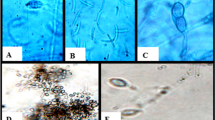Abstract
The bacterially mediated, anaerobic biodegradation of the explosive RDX (hexahydro 1,3,5 trinitro-1,3,5-triazine) is well established. Reports of successful mineralization of RDX by white rot fungi, and the enhanced transformation of RDX in stirred as compared to static composts, led us to study the possible aerobic role of several filamentous fungi in RDX biodegradation.Cladosporium resinae, Cunninghamella echinulata varelegans, Cyathus pallidus andPhanerochaete chrysosporium were grown in the presence of 50 and 100 μg ml−1 of RDX on a vegetable juice agar. Little inhibition of radial growth was observed, while control cultures with TNT exhibited substantial inhibition. When 100 μg ml−1 of RDX was added to pre-grown mycelia in a nonlignolytic liquid medium, between 12 and 31% was lost after 3 days. In similar experiments using14C-RDX, most of the label remained in the organic fraction, and little or none was found in the aqueous fraction, the volatile fraction or incorporated into cell walls. Although disappearance of RDX was observed for all four species tested, there was no evidence of mineralization. Mixed cultures of microorganisms, including both bacteria and fungi, merit further study as agents for the decontamination of munitions-contaminated soils.
Similar content being viewed by others
References
Dilley J, CA Tyson, RJ Spanggord, DP Sasmore, GW Newell and JC Dacre. 1982. Short-term oral toxicity of a 2,4,6-trinitrotoluene and hexahydro-1,3,5-trinitro-1,3,5-triazine mixture in mice, rats, and dogs. J Toxicol Env Hlth 9: 587–610.
Fernando T and SD Aust. 1991. Biodegradation of munition waste, TNT (2,4,6-trinitrotoluene), and RDX (hexahydro-1,3,5-trinitro-1,3,5-triazine) byPhanerochaete chrysosporium. In: Emerging Technologies in Hazardous Waste Management (Tedder DW and FG Pohland, eds), pp 214–231, American Chemical Society, Washington DC.
Funk SB, DJ Robers, DL Crawford and RL Crawford. 1993. Initialphase optimization for bioremediation of munition compound-contaminated soils. Appl Environ Microbiol 59: 2171–2177.
Griest WH, AJ Stewart, RL Tyndall, JE Caton, C-H Ho, KS Ironside, WM Caldwell and E Tan. 1993. Chemical and toxicological testing of composted explosives-contaminated soil. Environ Toxicol and Chem 12: 1105–1116.
Guo LY and WH Ko. 1993. Two widely accessible media for growth and reproduction ofPhytophthora andPythium species. Appl Environ Microbiol 59: 2323–2325.
Hathaway JA, and CR Buck. 1977. Absence of health hazards associated with RDX manufacture and use. J Occup Med 19: 269–272.
Horvath K and WL Alworth. 1993. Synthesis of14C-labelled hexahydro-1,3,5-trinitro-1,3,5-triazine (RDX). J Labelled Compounds Radiopharm 33: 467–471.
Isbister JD, GL Anspach, JF Kitchens and RC Doyle. 1984. Composting for decontamination of soils containing explosives. Microbiologica 7: 47–73.
Kaplan A, DF Berghout and A Peczenik 1965. Human intoxication from RDX. Arch Environ Hlth 10: 877–883.
Kaplan DL. 1990. Biotransformation pathways of hazardous energetic organonitro compounds. In: Biotechnology and Biodegradation: Advances in Biotechnology Series, Vol IV (Kamely D, A Chakrabarty and GS Omens, eds), pp 155–181. Portfolio Publishing Co, Woodlands, TX.
Kaplan DL. 1994. Biotechnology and biomediation for organic energetic compounds. In: Organic Energetic Compounds (Marinkas P, ed), pp 1–39, Nova Publishers, New York.
Ketal WB and JR Hughes. 1972. Toxic encephalopathy with seizures secondary to ingestion of composition C-4. Neurology 22: 871–876.
Kitts GL, DP Cunningham and PJ Unkefer. 1994. Isolation of three hexahydro-1,3,5-trinitro-1,3,5-triazine-degrading species of the family Enterobacteriaceae from nitramine explosive-contaminated soil. Appl Environ Microbiol 60: 4608–4711.
Knepshield JH and WS Stone. 1972. Toxic effects following ingestion of plastic explosive. In: Drug Abuse: Current Concept and Research (Keys WI, ed), pp 296–301, Charles CE Thomas, Springfield, IL.
McCormick NG, JH Cornell and AM Kaplan. 1981. Biodegradation of hexahydro-1,3,5-trinitro-1,3,5-triazine. Appl Environ Microbiol 42: 817–823.
McLellan WL, WR Hartley and ME Brower. 1992. Hexahydro-1,3,5-trinitro-1,3,5-triazine (RDX). In Drinking Water Health Advisory: Munitions (Roberts WC and WR Hartley, eds), pp 133–180, Lewis Publishers, Boca Raton.
Mylar CA and W Sysk. 1991. Bioremediation of explosives contaminated soils (scientific questions/engineering realities). In: Environmental Biotechnology for Waste Treatment (Sayler GS et al., eds), pp 137–146, Plenum Press, New York.
Osmon JL and RE Klausmeier. 1972. The microbial degradation of explosives. Dev Indust Microbiol 14: 247–252.
Rosenblatt DH, EP Burrows, WR Mitchell and DL Parmer. 1991. Organic explosives and related compounds. In: Handbook of Environmental Chemistry Vol 3 (Hutzinger O, ed), pp 195–234, Springer Verlag, Berlin.
Schneider NR, LB Sharon and ME Anderson. 1977. Toxicology of cyclotrimethylenetrinitramine: distribution and metabolism in the rat and the miniature swine. Toxicol Appl Pharm 39: 531–541.
Spiker JK, DL Crawford and RL Crawford. 1992. Influence of 2,4,6-trinitrotoluene (TNT) concentration on the degradation of TNT in explosive-contaminated soils by the white rot fungusPhanerochaete chrysosporium. Appl Environ Microbiol 58: 3199–3202.
Stone WJ, TL Paletta, EM Heiman, JI Bruce and JH Knepshield. 1969. Toxic effects following ingestion of C-4 plastic explosive. Arch Intern Med 124: 726–730.
Sublette KL, EV Ganapathy and S Schwartz. 1992. Degradation of munition wastes byPhanerochaete chrysosporium. Appl Biochem Biotech 34: 709–723.
Tan EL, DH Ho, WH Griest and RL Tyndall. 1992. Mutagenicity of trinitrotoluene and its metabolites formed during composting. J Toxicol Environ Hlth 36: 165–175.
Turley CP and MA Brewster. 1987. Liquid chromatographic analysis of cyclotrimethylenetrinitramine in biological fluids using solid-phase extraction. J Chromatog 421: 430–433.
Unterman R. 1991. What is theK m of disappearase? In: Environmental Biotechnology for Waste Treatment (Sayler GS, ed), pp 159–162. Plenum Press, New York.
Urbanski T. 1967. Chemistry and Technology of Explosives. Vol 3. Pergamon Press, Oxford.
Urbanski T. 1984. Chemistry and Technology of Explosives. Vol 4. Pergamon Press, Oxford.
Von Oettingen WF, DD Donahue, H Yagoda, AR Monaco and MR Harris. 1949. Toxicity and potential dangers of cyclotrimethylene trinitramine (RDX). J Indust Hygiene Toxicol 31: 21–31.
Williams RT, PS Zeigenfuss and WE Sisk. 1992. Composting of explosives and propellant contaminated soils under thermophilic and mesophilic conditions. J Indust Microbiol 9: 137–144.
Author information
Authors and Affiliations
Rights and permissions
About this article
Cite this article
Bayman, P., Ritchey, S.D. & Bennett, J.W. Fungal interactions with the explosive RDX (hexahydro-1,3,5-trinitro-1,3,5-triazine). Journal of Industrial Microbiology 15, 418–423 (1995). https://doi.org/10.1007/BF01569968
Received:
Accepted:
Issue Date:
DOI: https://doi.org/10.1007/BF01569968




